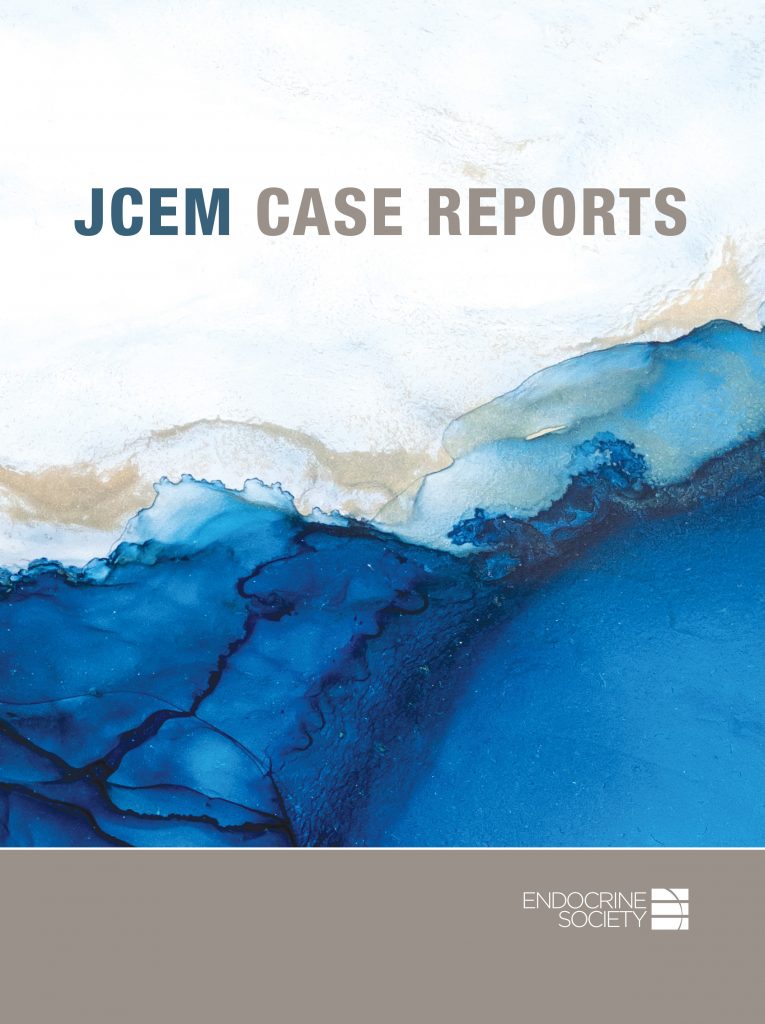For the ninth year running, Endocrine News talks to editors from Endocrine Society publications to unearth the endocrine nuggets of 2023. Here, the editors of The Journal of Clinical Endocrinology & Metabolism and JCEM Case Reports weigh in on what they think qualify as the year’s biggest discoveries in endocrine science.
Editor-in-Chief of JCEM, Paul M. Stewart, MD, FRCP, FMedSci, executive dean and professor at the University of Leeds School of Medicine in the United Kingdom says, “Efficacy and Safety of Fezolinetant in Moderate to Severe Vasomotor Symptoms Associated With Menopause,” by Johnson, K. A. et al. from the July issue of JCEM deserves special attention “…because its journey defines what JCEM is all about.”
Stewart further elucidates this journey: “Experimental medicine–based research published in JCEM going back several years defined the critical role for neurokinin B (NKB) acting via the neurokinin 3 receptor (NK3R) in controlling gonadotrophin-releasing hormone secretion in humans. Much of this work stemmed from innovative clinical investigation of patients with non-syndromic hypogonadotrophic hypogonadism. Subsequent work showed that the NKB/NK3R signaling pathway in the hypothalamus plays a key role in thermoregulation. Fezolinetant has been developed as a selective NK3R antagonist, and this seminal clinical trial paper published in JCEM helped the evidence base for FDA approval of fezolinetant as an oral medication to treat moderate to severe vasomotor symptoms (or “hot flashes”) caused by the menopause. The paper involves investigators from across North America and Europe and a strong industry partnership to tackle what is an important women’s health issue. It is highly likely to be the most down-loaded and highest cited JCEM original clinical article for 2023.”

“Experimental medicine–based research published in JCEM going back several years defined the critical role for neurokinin B (NKB) acting via the neurokinin 3 receptor (NK3R) in controlling gonadotrophin-releasing hormone secretion in humans. Much of this work stemmed from innovative clinical investigation of patients with non-syndromic hypogonadotrophic hypogonadism.” — Paul M. Stewart, MD, FRCP, FMedSci, editor-in-chief, The Journal of Clinical Endocrinology & Metabolism
More from JCEM Editors
For deputy editor Elizabeth N. Pearce MD, MSc, Boston University School of Medicine, Section of Endocrinology, Diabetes, and Nutrition, in Mass., “Proof-of-Concept and Randomized, Placebo-Controlled Trials of an Fcrn Inhibitor, Batoclimab, for Thyroid Eye Disease ,” by Kahaly, G. J. et al. and published in June in JCEM rose to the top.
“This is a report of two small trials of a novel agent, batoclimab, a monoclonal antibody that blocks neonatal fragment crystallizable receptor (FcRn)-mediated IgG recycling. This study demonstrated a marked decrease in TRAb and IgG titers and clinical improvements in patients with active thyroid eye disease (TED) who were treated with batoclimab, results which will inform forthcoming phase 3 trials. The possibility of an entirely new approach to the treatment of TED is exciting,” she says.
Pearce also selected two honorable mentions.
“Molecular Profiling of 50 734 Bethesda III-VI Thyroid Nodules by ThyroSeq v3: Implications for Personalized Management ,” by Chiosea, S. et al. from the November issue of JCEM stood out for “[improving] our understanding of the genetic landscape of biopsied nodules.”
“This paper reports detailed genetic information obtained from over 50,000 thyroid nodules, demonstrating that about two-thirds of Bethesda III and IV nodules lacked genetic alterations (and thus were likely benign) and most of the others were neoplasms driven by RAS-like genetic alterations,” Pearce says. “In contrast, most Bethesda V and VI nodules had BRAF-like alterations and were likely to harbor intermediate- and high-risk mutations.”
From Salas-Lucia, F. et al., “Effect of the Fetal THRB Genotype on the Placenta,” from the September issue of JCEM: “This is a report describing placentas from two different pregnancies in a woman with a THRB mutation,” explains Pearce. “In one of the pregnancies, the fetus also had the THRB mutation, while in the other pregnancy, the fetus was unaffected. Interestingly, in the placenta of the unaffected fetus, there were alterations in deiodinases, thyroid hormone transporters, and thyroid hormone nuclear receptors, which presumably served to protect the fetus from the toxic effects of thyroid hormone excess. This provides mechanistic insight into the placenta’s complex role in mediating the effects of maternal thyroid hormone on the fetus.”

Deputy editor Raghu G. Mirmira, MD, PhD, professor of medicine; vice chair for research, director, Translational Research Center at the University of Chicago, in Ill., gave three JCEM papers top billing, each about type 2 diabetes. About “Predictors of metformin failure: repurposing electronic health record data to identify high-risk patients,” by Bielinski, S. J. et al. from July, Mirmira says, “This study analyzed data from 22,047 diabetes patients who started metformin at three sites. The study found that 43% of them failed metformin within 18 months. The main predictor of metformin failure was the initial HbA1c level. Other predictors were age, sex, and race/ethnicity. The study proposed a model to stratify patients by their risk of metformin failure and might provide a clinical tool to assess the best approaches to the initial management of individuals with type 2 diabetes.”
Mirmira’s honorable mentions include “Ertugliflozin delays insulin initiation and reduces insulin dose requirements in patients with type 2 diabetes: analyses from Vertis CV ,” by Dagogo‐Jack, S. et al. from August. “The VERTIS CV trial tested the cardiovascular safety of ertugliflozin, an SGLT2 inhibitor, in patients with heart disease. The main findings were that ertugliflozin reduced the need for insulin therapy, delayed the start of insulin therapy by more than a year, and lowered the dose of insulin therapy in patients who were already using it, compared to placebo. Ertugliflozin did not increase the risk of low blood sugar episodes. These results suggest that ertugliflozin may help patients with type 2 diabetes and heart disease manage their blood sugar levels more effectively and safely,” he says.
From Borisov, A. N. et al. out just last month, is “Canagliflozin and metabolic associated fatty liver disease in patients with diabetes mellitus: new insights from canvas .” Mirmira says, “In a study on patients with advanced type 2 diabetes and high cardiovascular risk, the SGLT-2 inhibitor canagliflozin showed promising results. It improved liver-related outcomes, with 35.2% of patients on canagliflozin experiencing a significant improvement in liver enzyme levels compared to 26.4% in the placebo group. Canagliflozin also demonstrated positive effects on liver fibrosis and led to a notable weight reduction. These findings suggest that canagliflozin could be a valuable treatment option for patients with type 2 diabetes and metabolic dysfunction-associated fatty liver disease (MAFLD).”
Verónica Mericq, MD, of the Institute of Maternal and Child Research, School of Medicine, University of Chile in Santiago, highlights two papers to which she contributed from JCEM for their important updates in growth. One is “Management of Growth Disorders in Puberty: GH, GnRHa, and Aromatase Inhibitors: A Clinical Review ,” by Mauras, N; Ross, J., and Mericq, V. from January; the other is “International Consensus Guideline on Small for Gestational Age: Etiology and Management From Infancy to Early Adulthood,” by Hokken-Kelega, A. C. S. et al., published in May.
Mericq also gives another honorable mention to “New Horizons: Gonadotropin-Releasing Hormone and Cognition ,” from the November issue of JCEM by Prévot, V; Tena-Sempere, M; and Pitteloud, N, saying that “this particular manuscript describes novel actions of GnRh in neural circuits controlling brain maturation, odor discrimination, and adult cognition. These novel functions highlight potential areas that may be affected in children and adults using GnRh-A.”
“Efficacy and Safety of Fezolinetant in Moderate to Severe Vasomotor Symptoms Associated With Menopause,” by Johnson, K. A. et al. from the July issue of JCEM got another nod, this time from Whitney S. Goldner, MD, professor, Division of Diabetes, Endocrinology & Metabolism, at the University of Nebraska Medical Center in Omaha. Goldner says: “The reason I chose this article is because it represents a new therapy for women who are in menopause who are having bothersome vasomotor symptoms. This is exciting since many of our current options for therapy are suboptimal and do not completely alleviate their symptoms. It was well tolerated and has potential to become a great option for women with menopausal vasomotor symptoms, especially if hormonal therapy is contraindicated.”
David J. Handelsman, PhD, professor medicine, Concord Clinical School, ANZAC Research Institute, at the University of Sydney; Department of Andrology, Concord Hospital, in Australia
liked this JCEM paper from July by Equey, T. et al.: “Longitudinal Profiling of Endogenous Steroids in Blood Using the Athlete Biological Passport Approach ,” applauding its large prospective study and “using a Bayesian approach with specific targeting for an important antidoping objective.”
Handelsman’s honorable mentions are also from JCEM:
• “Efficacy and Safety of Fezolinetant in Moderate to Severe Vasomotor Symptoms Associated With Menopause ,” by Johnson, K. A. et al. from July
• “Ketone Body Infusion Abrogates Growth Hormone-Induced Lipolysis and Insulin Resistance ,” by Høgild, M. L. et al. from February
• “Serum Insulin-like Factor 3, Testosterone, and LH in Experimental and Therapeutic Testicular Suppression,” by Albrethsen, J. et al. from October
Jens Otto Lunde Jørgensen, PhD of the Aarhus University and Aarhus University Hospital, in Denmark highlights “The Socioeconomic Consequences of Cushing’s Syndrome: A Nationwide Cohort Study,” by Ebbehoj, A. et al., including Jørgensen himself, from the July 2022 issue of JCEM. “It is quite interesting since it documents in a new and intriguing way that Cushing syndrome exerts distinct adverse effects on socioeconomic outcomes, which are documented in an unbiased manner. Moreover, these effects are detectable several years before diagnosis. This illustrates the severity of the condition and demonstrates in an interesting manner that the patients have symptoms many years before the diagnosis is made,” he said.
From the Editor of JCEM Case Reports
William F. Young, Jr., MD, MSc, professor of medicine in the Mayo Clinic College of Medicine and Science in Rochester, Minn., says, “Choosing only one article for this Eureka! theme is nearly impossible. We have had so many great education cases published in the inaugural year of JCEM Case Reports! However, in the spirit of this assignment, I chose: ‘A False Pituitary Tumor’ from the May 2023 issue of JCEM Case Reports by Hurtado et al.”
Young says, “The authors share a case of pituitary enlargement, the cause of which all endocrinologists should be aware! Due to a cerebrospinal fluid (CSF) leak, the MRI scan may show the pituitary gland to be enlarged and diffusely enhancing following gadolinium administration. The authors discuss that this finding is an anatomical adaptation due to CSF volume depletion. Orthostatic headaches are a strong clue for the clinician to suspect that a CSF leak may be responsible for an apparent sellar mass. In addition, the non-pituitary findings on MRI are key. Prominent abnormal features include diffuse meningeal enhancement, sagging of the brain with tonsillar herniation and descent of the brainstem, engorgement of cerebral venous sinuses, and decrease in the size of cisterns and ventricles.” [Editor’s Note: This case was also highlighted in the October Endocrine News feature, “Stranger Things: A Look at Some Unusual Cases from JCEM Case Reports.]

“The authors share a case of pituitary enlargement, the cause of which all endocrinologists should be aware! Due to a cerebrospinal fluid (CSF) leak, the MRI scan may show the pituitary gland to be enlarged and diffusely enhancing following gadolinium administration. The authors discuss that this finding is an anatomical adaptation due to CSF volume depletion.” — William F. Young, Jr., MD, MSc, professor of medicine in the Mayo Clinic College of Medicine and Science in Rochester, Minn., editor-in-chief, JCEM Case Reports
Young’s honorable mention articles, each from the November issue of JCEM Case Reports, include:
- “A Case of Severe Lactation Ketoacidosis in a Nondiabetic Mother on a Ketogenic Diet,” by Borhan, M. et al. Young comments: “The authors report the case of a 31-year-old mother without diabetes mellitus who presented with life-threatening lactation ketoacidosis, after following a ketogenic diet while exclusively breastfeeding her newborn baby. The authors reminded us that lactating women are at risk of lactation ketoacidosis due to the increased calorie demand during breastfeeding, particularly if there is concomitant starvation, such as that observed in ketogenic diet regimens.”
- “Molar Pregnancy Induced Hyperthyroidism – The Importance of Early Recognition and Timely Preoperative Management,” by Walfish, L. et al. Young says: “This case highlights the importance of recognizing the link between gestational trophoblastic disease (GTD) and thyrotoxicosis — a recognition that is key to allow for timely initiation of appropriate preoperative treatment to prevent thyroid storm and also provide curative treatment for the GTD.”
- “Bilateral Cortical-sparing Adrenalectomy for the Treatment of Bilateral Aldosterone-producing Adenomas,” by Nanba, K. et al. Young explains, “The authors report a case of bilateral aldosterone-producing adenomas that were successfully resected by bilateral partial adrenalectomy. Long-term postsurgical follow-up in this patient documented clinical and biochemical resolution of primary aldosteronism without need for glucocorticoid replacement therapy.”

Horvath is a Baltimore, Md.-based freelance writer, a frequent and prolific contributor to Endocrine News, and has compiled and written the annual “Eureka!” articles annually for nine years.

